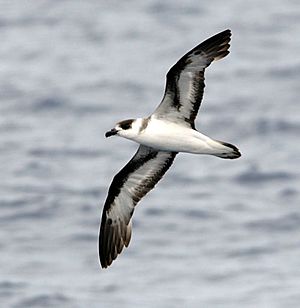Black-capped petrel facts for kids
Quick facts for kids Black-capped petrel |
|
|---|---|
 |
|
| Conservation status | |
| Scientific classification | |
| Genus: |
Pterodroma
|
| Species: |
hasitata
|
 |
|
The black-capped petrel (Pterodroma hasitata) is a special seabird. It is also known as the diablotín. This name means "little devil" in Spanish. It lives in the West Indies. This bird has long wings. Its back and wings are grey-brown. It has a white neck and rump. Its belly is mostly white. It has a black cap on its head. This cap can sometimes cover its eye. It also has some dark marks under its wings. The petrel eats food like squid. It picks food right from the ocean surface.
Contents
What is a Black-capped Petrel?
The black-capped petrel is a fairly large seabird. It is about 16 inches (40.5 cm) long. Its wings can spread up to 37 inches (94 cm) wide. The name Diablotín comes from its habits. It flies at night. It also makes strange sounds. Locals thought these sounds were from evil spirits. Sometimes, the petrel makes other noises. These sounds happen when it looks for food at sea.
This petrel is active at night where it breeds. This might be to avoid predators. Predators include gulls, hawks, or crows. Like most petrels, it cannot walk well. It can only shuffle a short distance. This helps it get to its nest burrow.
Types of Black-capped Petrels
There are two main types of black-capped petrels. One type has a dark or black face. The other has a light or white face. Scientists have studied their genes. They found that these two types are different. They might be separate groups that breed apart. But it is not clear if they are different species. They could also be different subspecies. Sometimes, birds are found that look like a mix of both types.
Where Do Black-capped Petrels Live?
Their Home Range
This seabird used to breed in many places. It lived on steep mountainsides. These were in the Greater Antilles. Now, only three main breeding areas remain. These are in the high mountains of Hispaniola. You can find them in the Dominican Republic. They are also in Haiti. In 2015, birds were found nesting on Dominica. People had thought they nested there before. One mountain peak in Haiti is still called "Mont Diablotin." This name reminds us of the "little devil" bird.
The petrels find food in the warm waters. These waters are part of the Gulf Stream. Most birds stay off the United States coast. This is between Florida and North Carolina. But they can fly far north and east. Some have even been seen near Europe. They are found in the Gulf Stream all year. Birds seen there during breeding season are either not breeding. Or they are flying far from their nests to find food. The black-capped petrel mostly stays over the open ocean. It often flies with other seabirds. These can include shearwaters and terns.
How They Nest
Like other petrels, they nest in burrows. These burrows are in remote highland areas. They are found on islands. The burrows are usually on forested cliffs. This makes them very hard to find. The birds visit their burrows at night. This helps them avoid being seen by predators. Eggs are usually laid in January. They hatch around March. The young birds, called fledglings, leave the nest in June or July.
Protecting the Black-capped Petrel
This species was once common in the Caribbean. But its numbers have dropped a lot. It is now one of the most endangered seabirds. It is in the North Atlantic. In the early 1900s, some thought it was extinct. But now, there are about 2,000 to 4,000 birds. In 1963, a team found 11 breeding groups in Haiti.
Most threats to the petrel are where it nests. These threats include losing their habitat. This means their homes are destroyed. Also, new predators have been brought in. People also used to hunt them. Hunting is less common now. This is partly because there are so few birds left. Deforestation is a big problem. This is when forests are cut down. Wildfires also destroy their homes. This is especially true in Haiti. Haiti has lost many forests recently.
Plans to save the petrel are in place. They focus on protecting forests. These are around known nesting areas. Scientists also watch and search for burrows. There are also worries about oil and gas activities. These activities could harm the birds. In 2018, the US Fish and Wildlife Service suggested listing the petrel as threatened. In 2023, they asked for more comments. This was because threats might be worse than thought.


